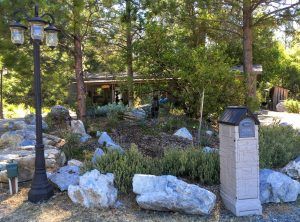My large front yard is ringed by soaring pine, cedar and oak trees, which give me no end of happiness. But because I’ve planted hardy, deciduous shrubs and perennial beds that die back to the ground in winter, my “garden” is barren for months.
While I do love the magic of watching deciduous shrubs and perennials (viburnum, Russian sage, coneflower) come back to life in spring, in January and February I’d love to have more eye-level greenery in my garden. Time to research.
Here’s what I’ve found so far: hardy, varied shrubs native to either California or North American that not only please the eye and create cozy garden rooms, but also offer nesting sites and protective cover for birds and other small wildlife.
One caveat before we start: the bushes mentioned below are all hardy in our Zone 7 foothills, but if you live in the high country, you might need to look for more cold-hardy options.
California Native Evergreen Shrubs
First, a plug for the California Native Plant Society’s website, calscape.org, where you can search by region, plant category and name. For any given plant, you’ll learn about its growing habits and care, which wildlife it supports (mostly birds and insects), how to propagate it and suggestions for companion planting.
Oregon grape (Berberis aquifolium), also native to California, grows from 3.5 to 7ft tall and 6ft wide, has dark green leaves, clusters of mildly fragrant yellow flowers in spring followed by purple, edible berries that resemble grapes.
The wide-ranging forms of bush California lilac (Ceanothus) are wonderful. The most familiar are the purple-flowering varieties that grow in full sun on our hillsides. Other varieties range in height and flower color. Bees love Ceanothus.
And of course, there’s the ubiquitous manzanita (Arcostaphylos)—love ‘em or hate ‘em—with its smooth red bark, gray-green leaves, and tiny pink flowers.
North American Native Evergreen Shrubs
If you broaden your search to North American natives, you’ll have many more options. Here are a few beauties to consider:
Escallonia – A dense, fast-growing shrub to 8ft tall and 6ft wide, with clusters of rosy-pink flowers in spring through summer.
American Holly (Ilex opaca) – A beautiful, slow-growing bush or tree with classic Christmas decoration appeal, the holly’s bright red berries are beloved by birds (but poisonous to humans).
Arborvitae (Thuja) – These popular shrub- to tree-size plants make great windbreaks and privacy screens. Typically pyramidal in shape, their foliage is similar to our cedar trees, so they complement foothill gardens. Its name is Latin for “tree of life” because of the supposed medicinal qualities of its sap, twigs and bark.
Juniper (Juniperus) – There is a mind-boggling range of junipers, from groundcovers to bushes and trees, native to North America and around the world. These sun-loving, drought-tolerant, resinous conifers tend to be more deer resistant than arborvitae. Plus, their berries can be used as a spice.
A smart selection of native evergreen shrubs can lift the winter woes, offer protection and food for wildlife, and create architectural structure for your soon-to-be-flowering spring garden.
Happy planting!
For more information about all things yard and garden, visit the University of California Agriculture and Natural Resources site, https://ucanr.edu/Focus_Areas/?focus_area_id=6
Rachel Oppedahl is a University of California Cooperative Extension Master Gardener of Tuolumne County.

